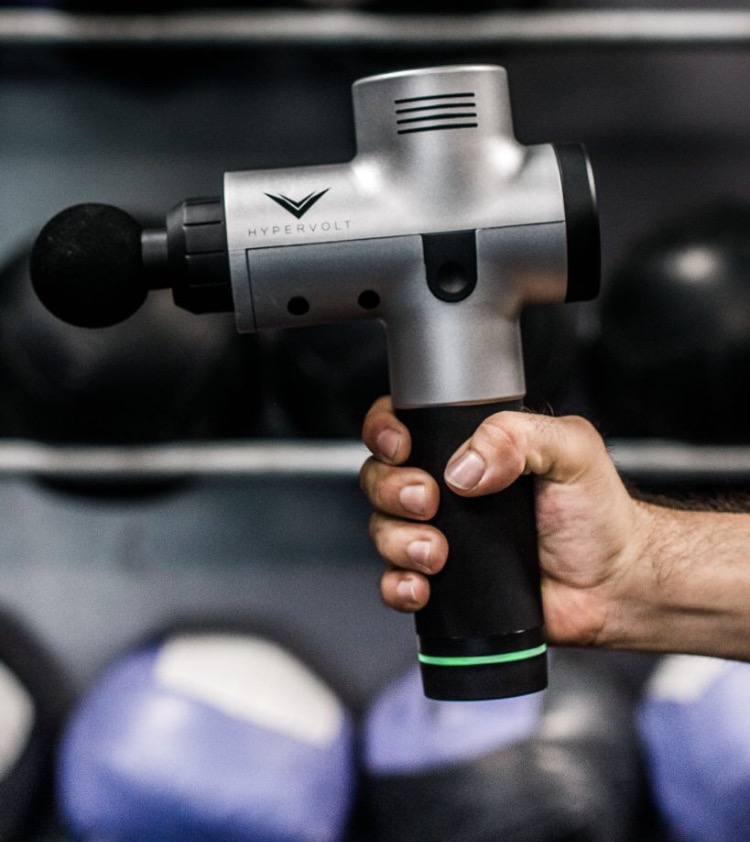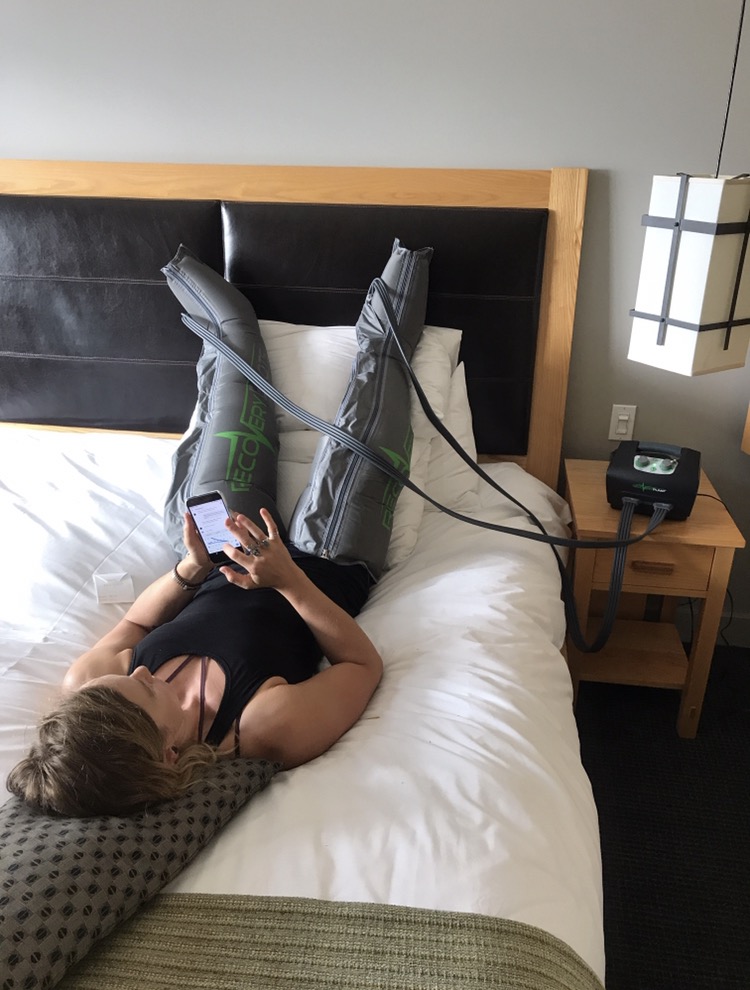How to Really Recover Right
03.05.2019 | Ski Racing Staff

About the Author
Lindsay Winninger is a physical therapist bringing over 10 years of experience to the sports medicine and orthopedic world. She is currently the owner of Sports Rehab Consulting, a concierge physical therapy company based in Colorado. Prior to forming SRC, Lindsay worked at Howard Head Sports Medicine where she specialized in hip and knee injuries, as well as return-to-sport progression. Lindsay was the head physical therapist for the US Ski Team for 2 seasons, including covering the women's alpine team at the Sochi Winter Olympics. Lindsay went on to be Lindsey Vonn’s full time private physical therapist. Lindsay has treated, guided, and rehabbed athletes in the NFL, NHL, NBA, MLB, PGA, MLS, WTA, as well as collegiate and Olympic athletes in various sports.
One of the most overlooked components of athlete performance is recovery. The relationship between the stresses and strains athletes put on their bodies and how fast they can recover from those demands is something to be attended to. Skiers tax their bodies in the gym, training on snow, and in competition and recovering adequately between those demands is essential to achieving results. It’s hard to perform your best and achieve results, at any age, if your body is in a constant state of fatigue. Fatigue can come from a number of things, a hard gym workout, heavy volume on snow, injury, or stressors in life such as pressure to perform, social stress, or burnout.
Essentially, the recovery phenomenon dictates that athletes need adequate time to recuperate after training and competition, both emotionally and physically. This recuperation can be anything from timed rest in between sets in the gym, to longer rest periods of hours, to days in between heavy training or competition. This calculated downtime or rest period allows our bodies to recuperate fully.
Monitoring your own personal recovery and developing a plan or strategy unique to your own needs is essential in maximizing performance outcomes. There is no one-size-fits-all recovery solution. Age, gender, fitness level, and physiological makeup will all play a role in recovery timelines. Therefore, recovery should always be individualized. For example, you may have 10 athletes that all perform the same workout. Some will be sore the next day and some will be sore 48 hours later. Everyone’s body responds differently to the stress and demands placed on it. Learning your body and what it needs to recover and feel recharged will undoubtedly increase your ability to carry out those workouts at a higher intensity level and achieve better results. The most important thing to understand is that while a workout is beneficial, you don’t actually benefit from that workout until your body recovers. You want that hard work to pay off and the answer is balancing out that workout. Many believe that the recovery after a workout is just as important as the workout itself.
While the most obvious benefit of recovery is feeling more energized, research has shown that implementing a recovery plan promptly after workouts have helped combat illness, decrease injury rates, decrease fatigue, improve sleep, and mitigate overtraining syndromes. If you continue to push yourself without incorporating recovery something will eventually break down.
There is an insane number of recovery strategies and approaches used by athletes today and they span from everything such as adequate nutrition and hydration to lasers and infrared saunas to hyperbaric chambers and altitude tents. Some recovery interventions are supported by strong scientific research, while others continue to be investigated and tested. The biggest things to take into consideration and ask yourself when building your recovery plan is: What are my goals, what is my recovery intervention targeting or helping with, and the timeframe in which to implement it. Identify if it is a short-term or long-term recovery strategy. For example, a short-term recovery goal would be increasing tissue mobility and decreasing muscle soreness after a high-intensity lifting session, whereas a long-term recovery goal may be working in appropriate days off in your winter race schedule. Focus on creating both a short-term and long-term recovery plan.
While there are numerous recovery strategies, devices, and tools out there, I will review some of the more popular and travel-conscious ones in this article. After all, the majority of people do not have access to a light pod, deprivation chamber, or personal chef!
STRETCHING
Two types of stretching are generally well known – static and dynamic. During static stretching each position is held for 15-20 seconds and during dynamic stretching, stretches are performed actively with movement for three to five seconds. The goal of stretching is to improve flexibility, mobility, and to possibly achieve muscle relaxation. The benefits of static stretching for recovery is still debated in literature. Research has shown that dynamic stretching will yield more benefit. Stretching is not recommended directly after a high-intensity workout or training session as you want to minimize reversing the gains and muscle adaptations from your session. Stretching can be used prior to workouts and after two hours post workout.
ACTIVE RECOVERY
Active recovery, also known as cooling down, can be implemented directly after working out. Low-intensity exercise that targets the muscle groups your just hammered in your workout can help with metabolic waste removal (ex: lactate in blood) and muscle cell recovery. Riding the bike on low resistance or walking for 10 minutes will allow your body to dissipate heat, reduce your heart rate, and promote recovery of your cardiovascular and respiratory systems. Research still debates if performing an active recovery session directly after exercise will indeed reduce muscle soreness and stiffness. This then becomes individualized, where if you feel better, you feel better.
HYDRATION
Fluid intake before, during, and after exercise will help you perform your best. According to USADA (US Anti-Doping Agency) research shows that we need 24 ounces of water for every pound lost during workouts. Losing as little as two percent of your body weight during exercise can create a negative effect on performance. Keeping yourself hydrated via water, electrolyte mixes, or low sugar sports drinks will keep your body moving and prevent dehydration. There are two easy ways to check hydration levels. The first is weighing yourself before and after a training session and targeting fluid replacement based on weight loss during exercise and the second is checking your urine color. Our urine can tell us a lot about our hydration levels. The darker your urine the worse off and more dehydrated you are. Shoot for pale yellow, the clearer the better. Hydration is often missed in recovery planning.
NUTRITION
Your body runs on what you put in it. Having adequate nutrition before and after exercise is imperative to getting the most out of your workouts and recovering. If you haven’t eaten in several hours prior to working out, you are running on an empty tank. Therefore energy levels will be lower during your session and fatigue can often set in faster. That being said, we deplete those food energy stores during exercise and replenishing the tank post exercise is crucial to recovery. You can dial in your post-exercise shake or snack with adequate protein and carbohydrate sources based on the intensity with which you just worked out. Replenishing your body within 20 minutes of working out will help stimulate muscle protein synthesis rates, fuel muscle building, and ensure that your body has the nutritional means to help repair itself before the next workout
VIBRATION MASSAGE THERAPY
Vibrational massage devices have been around a long time, but recently they have become more portable and more cost-conscious. These devices aim to create vibrations that can penetrate different levels of tissue. Often, there are different speed settings that dictate the number of percussions felt. The thought is that the vibrations penetrate deeper into the tissue or muscle than a traditional massage or foam roller. These devices hope to target an increase in circulation as well as address trigger points and areas of stiffness in the muscle. With increased circulation, a warming effect occurs which can create a mechanism for muscle relaxation. The Theragun, Hypervolt, G5, and DMS are just a few devices currently on the market. These are great devices if you find your body to be struggling after high-intensity exercise or competition.

The Hypervolt 5 is a vibrational massage tool used to increase circulation and address trigger point issues to aid recovery.
FOAM ROLLING
Foam rolling is a manual therapy technique used before and after exercise. Use of a foam roller aims to release tissue and muscle restrictions. While debated, foam rolling claims to create a short term effect on muscles by increasing flexibility and range of motion before exercise. In terms of recovery, foam rolling may dissipate muscle soreness and stiffness post workout. In the research, no objective markers have been consistently proven, but subjectively it has been shown to be beneficial. The bottom line is, if it makes you feel better, do it. No optimal protocol has been established in terms of sets, reps, or intensity levels. Duration and style vary person to person. Vibrational foam rollers have also hit the market and have been shown to penetrate deeper into the muscle, as much as twice the depth of a traditional foam.
POOL RECOVERY
Utilizing the pool for an active recovery session is great. In the pool, you are able to unweight your body via water’s buoyancy properties. The more you submerge your body, the more you unweight yourself. For example, in waist deep water, you unload your body at 50%. In chest deep water 75%. Pool routines for recovery can be anything from walking to dynamic stretching, or performing a short series of exercises. Swimming laps at a low intensity and speed is also a good way to actively recover. Spending time in the pool has been shown to increase circulation via hydrostatic pressure. Hydrostatic pressure is a pressure that is created against your body the deeper you are submerged in water. A big advantage of this pressure is its ability to increase circulation and assist in blood return. This improved circulation helps increase detoxification in the blood and to aid in metabolic waste removal. This increased circulation is also good for flushing out swelling and edema for those of you who may be nursing an injury. Shoot for a pool temperature of 79-85 degrees, a little warmer is better. Perform exercises and dynamic stretches in chest deep water. Time your pool recovery session to last at least 23 minutes to reap the benefits of the pool.
MASSAGE
Who doesn’t love a good massage? The recovery aspects of massage have been thoroughly researched in terms of fascial release, increased range of motion, metabolite reduction, blood flow, delayed onset muscle soreness, and improving the time muscles may need to recover. Relaxing effects can be both psychological and physical. Massage has shown in some to subjectively also reduce stress. There are various types of massages and based on the technique performed each massage may address different things. For example, a lymphatic massage addressing the lymph nodes from your feet to your head (in that order) usually will target full body recovery. Addressing the lymph nodes and circulatory system will work to flush metabolites from the body and help to delay the onset of muscle soreness. Whereas a deep tissue massage may specifically target muscles or trigger points and work to reduce stiffness or areas of overuse.
HOT/COLD CONTRAST BATHS
The theory behind contrast baths is that alternating between hot and cold water will create a pumping and flushing mechanism within our bodies. By attempting to constrict our blood vessels (cold water) and then dilate our blood vessels (hot water) we work to create a pumping mechanism in our vessels to aid in circulation and promote metabolic waste removal after a workout. There are several protocols for contrast baths that exist, as the time spent in each temperature can target different things. In terms of recovery, start with rounds of one minute in hot water submersion followed by one minute in cold water submersion. Eight rounds, (eight minutes in hot water, eight minutes in cold, ending in the cold) Ideally, you would like to work up to four minutes in the hot water followed by four minutes in the cold water, for two to three rounds. Not everyone can handle four minutes in frigid water though. Most research studies shoot to have water temperatures of 45-68 degrees for the cold tub and 93-106 degrees for the hot tub.
DYNAMIC COMPRESSION DEVICES
Compression devices targeting our legs and arms have been widely used by athletes over the last decade. Compression pants, boots, and arm sleeves can be hooked to a device that systematically compresses air and then releases it in order to promote circulation via dynamic pulsing. This has been shown to increase blood flow, lymphatic drainage, and subjective perceived recovery. Several different machines are available, such as the Recovery Boots System and the NormaTec Recovery System.

Nastar National Pacesetter and U.S. Ski Team member, Laurenne Ross, uses leg compression sleeves on her legs after a workout.
SLEEP
Sleep is hands down the most important aspect of recovery that exists. Ensuring an athlete is getting both quality and quantity sleep will aid in performance and recovery. Plenty of research is available demonstrating these benefits and showing that there is a direct correlation with performance. There are a lot of sleep monitoring apps, bracelets, heart monitors, rings, etc these days that claim to track sleep. Some of these methods are more accurate than others. Knowing your sleep duration and planning to address your sleep routine is imperative to attain a good night’s rest. A few tips for achieving a good night’s rest are not using your phone, tablet, or computer 30 minutes before bed, do not perform any intense physical training after 6 p.m., keep your room dark and cool, avoid caffeine after lunch, be cautious of sleep aids such as Ambien and melatonin as they can actually disrupt recovery, and establish a set bedtime routine.
While these recovery strategies, devices, and tools just scratch the surface of what is available, some of these strategies listed are essential to performing your best. Remember to create short and long term recovery plans and think about what you need personally to recover and recuperate.